Selçuk is a very common stop on the Turkish backpacker route and it’s not hard to see why: it’s located on the Aegean but it’s pretty much the midpoint between Istanbul and the Mediterranean coast (located 9 hours from Istanbul and about the same from Fethiye), and it boasts some of the best-preserved Greco-Roman ruins this side of, well, Rome! We didn’t realize how many modern-day Turkish cities have a Greek or Roman history, but it makes sense, given Turkey’s location and the fact that the Roman empire pretty much dominated most of the lands around the Mediterranean at one point.
In fact, there are some pretty cool ruins right in town: the Selçuk Citadel and St. John’s Basilica.

View of the Selçuk Citadel, with St. John’s Basilica ruins in the foreground.
The coolest thing we learned from wandering these ruins is the fact that Romans often repurposed old construction materials (like columns) to build their cities. Romans—ancient architectural refashionistas!
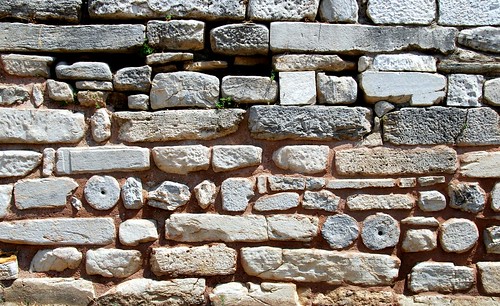
Bits of columns reused to construct the walls of St. John’s Basilica.
But the star of the ruins show is Ephesus, which is located right outside of Selçuk. It’s a neat place, with lots of major landmarks, and it allows you to imagine what life must have been like under the Roman empire.
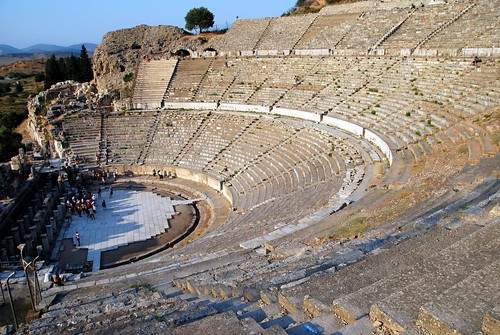
The Great Theater in Ephesus, where plays were acted out and gladiator battles fought!
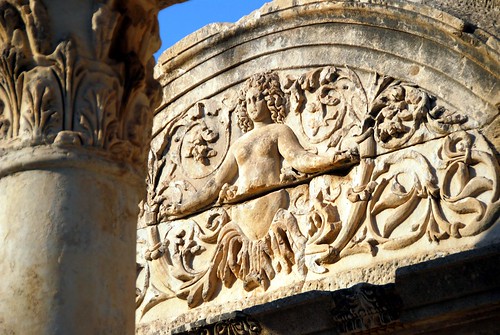
Detail, the Temple of Hadrian.
The crown jewel of Ephesus is the Library of Celsus, an imposing structure where the Romans stored thousands of “books” (i.e. scrolls). Like many classical structures (ex. the Parthenon), the design of the Library of Celsus employed some ingenious optical illusions to make the building appear more grand—the central entrance is larger than the other two flanking it, and the columns in the center are slightly bigger than the columns used on the outside of the building. The detail of the carvings on the library’s facade are really impressive.
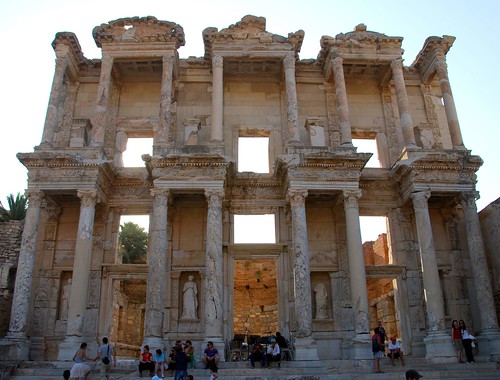
The crown jewel of Ephesus: the Library of Celsus, where the Romans stored thousands of “books” (i.e. scrolls).
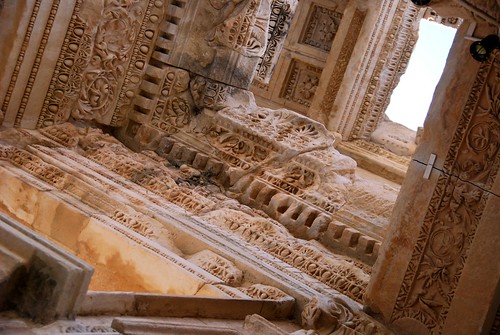
Detail, the Library of Celsus.
Our usual M.O. when visiting a major tourist site is to show up either right after opening or right before closing to avoid the masses, and we did the same with our visit to Ephesus—arriving only 2 hours before the park closes at 6pm. Unfortunately, it seems a tour group consisting of a bunch of very loud Italians had the same idea. So our experience of the ruins wasn’t that great—it felt kind of busy and loud and honestly a bit claustrophobic…but I guess that’s a pretty close approximation of what it would have been like to live in a bustling Roman city!
Most travelers stay in Selçuk for a day or two to see Ephesus before moving on. Since Selçuk was a pleasant enough town, we decided to stick around for another day and head into the countryside. A medium-sized town called Tire was having their local market on Tuesday, and though it wasn’t quite what we expected—lots of “made in China” clothing and goods—it put us within spitting distance of a town called Kaplan, where you can have lunch on the hill overlooking the town of Tire. Though the taxi ride to Kaplan made it kind of an expensive excursion just for a meal, the food was worth it! Turkey is one of the few countries in the world right now that supports its own food requirements—which is really awesome until you realize that means tomatoes, cucumbers, and olives are going to constitute the entirety of your vegetable diet. So we were understandably very excited when this beautiful little restaurant in Kaplan served us stuffed squash flowers, homemade yogurt, and a salad! With lettuce! And it was cheap (if you don’t count the taxi ride)!
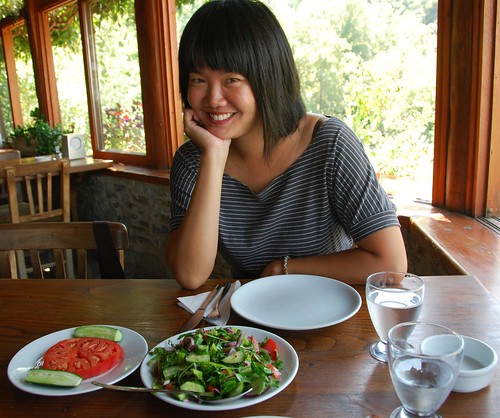
A salad worth a smile—lettuce! In Turkey! And not just some cheap iceberg—we’re talkin’ about dark green leaves in this salad!
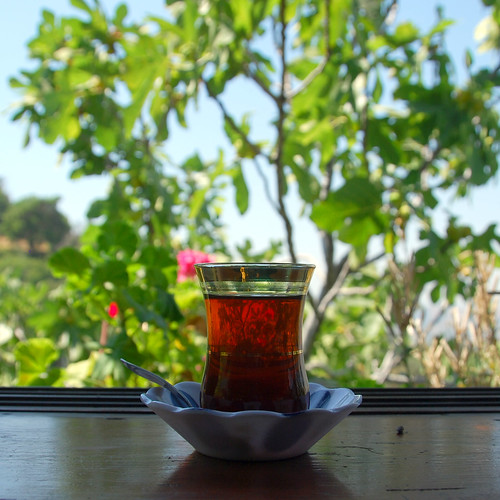
We drank this stuff all day long while we were in Turkey—Turkish tea.
Our next excursion wasn’t as successful—we heard that a town called Sirinçe was really beautiful, so we hopped the local bus (called a dolmuş) and headed for the hills. Unfortunately, it turned out to be a really lame town which was centered around a street full of shops selling tourist souvenirs. Some people are probably charmed by the whitewashed buildings, but this place was not for us.
We had a nice enough time in Selçuk, and if you’re really into ruins, then this is the place for you. I think that was the major lesson of our time in Selçuk—we’re not really “ruins people”…unless there is a really interesting landscape to go along with those ruins. ![]()
How we got from Istanbul to Selçuk: We showed up at Istanbul’s massive bus station and walked around to a few bus company offices until we found the lowest price (35 lira each from Istanbul to Izmir, where you can catch a van to Selçuk for an additional 7 lira). This was our first experience with Turkish buses—which have an excellent reputation—and the trip didn’t disappoint! A bus attendant wearing a bow tie, vest, and cummerbund (which matched the bus company’s colors!) serving us Turkish tea, cakes, and spring water on our 9 hour ride.
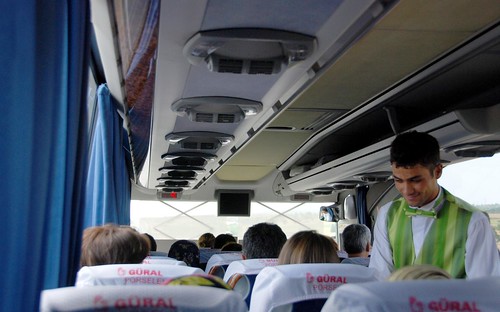
Turkish bus attendant serving tea and cakes on the drive from Istanbul to Izmir.
How we got from Selçuk to Tire, Kaplan, and Sirinçe: Took the local bus (basically a large van) from Selçuk to Tire for 6 lira and then a taxi from Tire to Kaplan (there is no public transport for this route). We also took the local bus to Sirinçe.
Where we slept in Selçuk: Turkish people are so amazing that we finally let down our guards, and for the first time on the trip, we went with the hotel touts at the bus station…and we weren’t disappointed! We stayed in a double ensuite at the Canberra Hotel for 50 lira (US$32). The room was very comfortable (and colorful!) and the views from the rooftop restaurant (where you have breakfast) were excellent. The hotel offers free rides to Ephesus, and since it is staffed by an enormous Kurdish family, inevitably some cousin or nephew will end up taking you to the ruins.
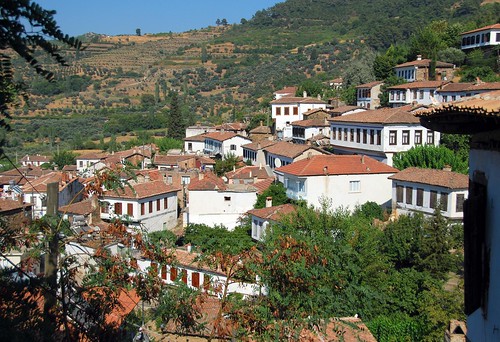
Simple pleasures — dark green lettuce and Turkish tea.
Sirince reminded me of San Clemente.
Thanks for the great pics and post about our town of Selcuk. I’m lucky enough to see that Basilica wall of recycled columns right outside our door. We sadly agree about Sirince - I’m so sorry it was ever ‘discovered’. We do grow more veggies than the classic three you mention, and arugula is a staple. And thankfully, I’ve never seen iceberg in Selcuk!